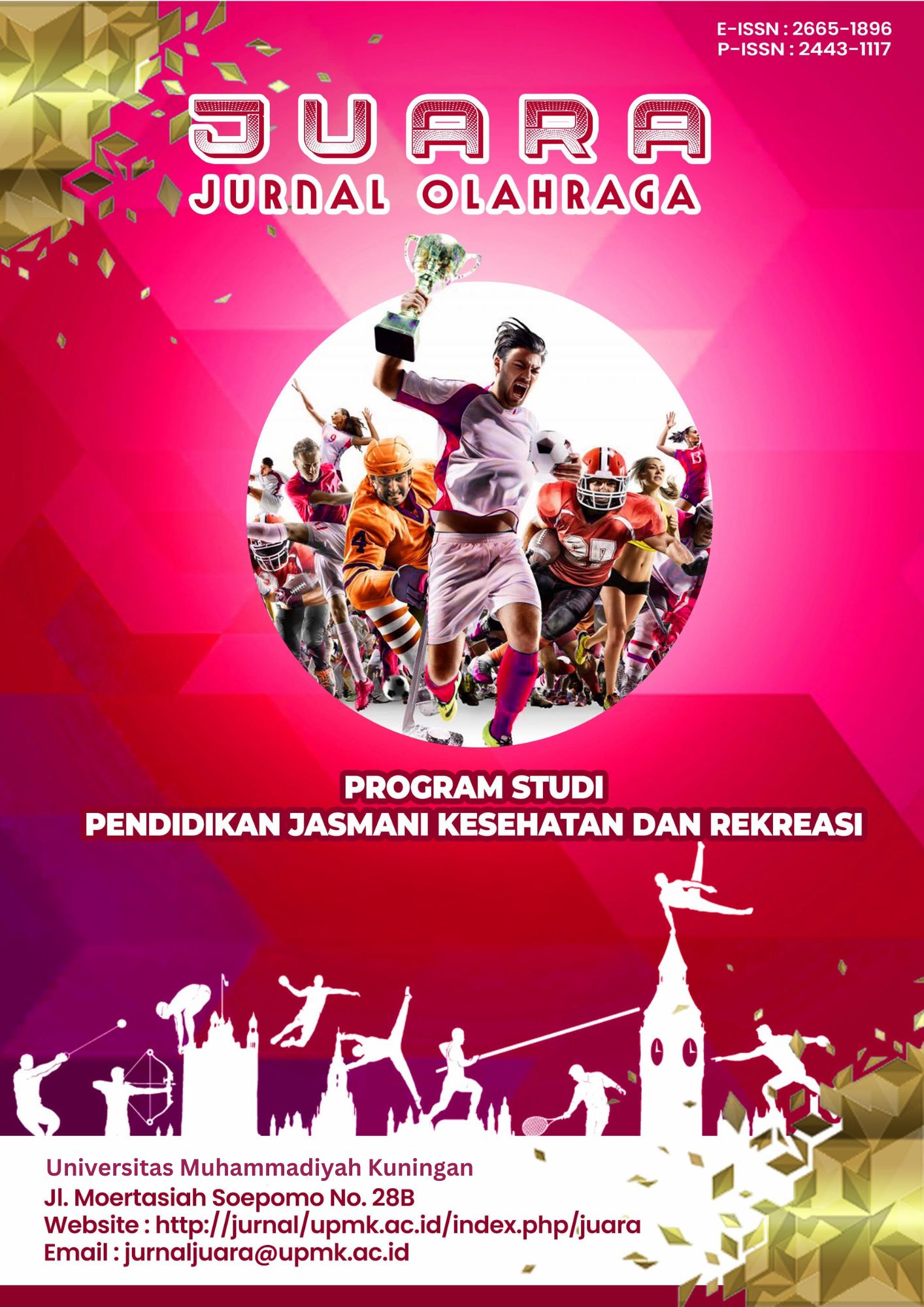Abstract
This study aims to identify the relationship between mental imagery training and anxiety control in handball athletes in Cianjur. The problem of anxiety is often psychological factors that hinder athlete performance, especially when facing pressure in competition. The research method used is a quantitative approach with a correlational design. The sample in this study was 28 handball athletes selected through purposive sampling techniques. The research instrument was a questionnaire that has been tested for validity and reliability. The results showed that there was a very strong and significant relationship between mental imagery training and athletes anxiety control (r = 0.770; sig = 0.001). In addition, the results of a simple linear regression analysis showed that mental imagery training contributed 59.2% to anxiety control. This finding indicates that the better an athlete is at implementing mental imagery training, the higher their ability to control anxiety.This study contributes to the development of mental training strategies in sports, especially in improving the psychological readiness of handball athletes. Mental imagery training can be used as a practical approach by coaches to manage competitive pressure experienced by athletes before and during matches.
References
Bacić, P., Antonijević, M., Bjelica, D., Božić, M., & Sporiš, G. (2022). Mental skills in Serbian handball players: In relation to the position and gender of players. Frontiers in Psychology, 13, Article 960201. https://doi.org/10.3389/fpsyg.2022.960201
Booth, T., Doumas, A., & Murray, A. L. (2017). Hypothesis testing. In V. Zeigler‑Hill & T. K. Shackelford (Eds.), Encyclopedia of Personality and Individual Differences (pp. 1–4). Springer. https://doi.org/10.1007/978‑3‑319‑28099‑8_1310‑1
Di Corrado, D., Guarnera, M., Guerrera, C. S., Maldonato, N. M., Di Nuovo, S., Castellano, S., & Coco, M. (2020). Mental imagery skills in competitive young athletes and non-athletes. Frontiers in Psychology, 11, 633. https://doi.org/10.3389/fpsyg.2020.00633
Fekih, S., Zguira, M., Koubaa, A., Bettaieb, J., & Hajji, H. (2021). Effects of mental training through imagery on the competitive anxiety of adolescent tennis players fasting during Ramadan: A randomized, controlled experimental study. Frontiers in Psychology, 12, 713296. https://doi.org/10.3389/fpsyg.2021.713296
Hair, J. F., Black, W. C., Babin, B. J., & Anderson, R. E. (2010). Multivariate data analysis (7th ed.). Upper Saddle River, NJ: Pearson Prentice Hall.
Holmes, P. S., & Collins, D. J. (2001). The PETTLEP Approach to Motor Imagery: A Functional Equivalence Model for Sport Psychologists. Journal of Applied Sport Psychology. https://doi.org/10.1080/10413200109339004
Kaya, E., & Biçer, T. (2025). Imagery and competitive anxiety in Turkish national athletes: A study during the Oran 2022 Mediterranean Games. Spormetre: The Journal of Physical Education and Sport Sciences, 23(1), 154–167.
Kumar, S. (2016). The effect of mental imagery upon the reduction of athletes’ anxiety during sport performance. International Journal of Physical Education, Sports and Health, 3(6), 186–188.
Liu, Y., Zhao, S., Zhang, X., Zhang, X., Liang, T., & Ning, Z. (2025). The effects of imagery practice on athletes’ performance: A multilevel meta-analysis with systematic review. Behavioral Sciences, 15(5), 685. https://doi.org/10.3390/bs15050685
Meshkini, A., & Mousavi, S. H. (2011). The effect of mental imagery upon the reduction of athletes’ anxiety during sport performance. The International Journal of Academic Research in Business and Social Sciences, 1(3), 23–33.
Nikolić, N., Todorović, B., & Antić, M. (2022). Mental skills in Serbian handball players: In relation to the position and gender of players. Frontiers in Psychology, 13, 926368. https://doi.org/10.3389/fpsyg.2022.926368
Ningsih, M. Y., & Rinaldi. (2024). The relationship of mental toughness to competitive anxiety in SMAN 4 West Sumatra athletes (sports specialization). In Trend: International Journal of Trends in Global Psychological Science and Education, 1(3), 1–10. https://doi.org/10.62260/intrend.v1i3.147
Nopiyanto, Y. E., Alexon, A., Raibowo, S., Prabowo, A., Ilahi, B. R., & Widodo, L. (2022). Pengaruh Latihan Imagery terhadap Kepercayaan Diri Atlet. Jurnal Patriot, 4(1), 48–57. https://doi.org/10.24036/patriot.v4i1.834
Paivio, A. (1991). Dual coding theory: Retrospect and current status. Canadian Journal of Psychology / Revue Canadienne de Psychologie. https://doi.org/10.1037/h0084295
Pedersen, S. M. M., & Johansen, B. T. (2023). Flow training program: Mindfulness, decision making, and mental well-being of young and adult elite handball athletes. Sports, 12(6), 160. https://doi.org/10.3390/sports12060160
Pranata, D. (2022). Pengaruh Olahraga Dan Model Latihan Fisik Terhadap Kebugaran Jasmani Remaja. Jurnal Kesehatan Olahraga, 10, 107–116.
Rohendi, A., & Rustiawan, H. (2020). Kebutuhan Sport Science Pada Bidang Olahraga Prestasi. Journal Respecs, 2(1), 32. https://doi.org/10.31949/jr.v2i1.2013
Simonsmeier, B. A., et al. (2021). The Effects of Imagery Practice on Athletes’ Performance: A Multilevel Meta‑Analysis. Behavioral Sciences.
Supriyatni, D., Rizal, R. M., & Rasyad, R. M. (2020). Hubungan tingkat kecemasan terhadap performance atlet dayung Traditional Boat Race (TBR). Jpoe, 2(1), 127–134. https://doi.org/10.37742/jpoe.v2i1.32\
Strachan, L., & Munroe‑Chandler, K. (2006). Using imagery to predict self‑confidence and anxiety in young elite athletes. Journal of Imagery Research in Sport and Physical Activity. https://doi.org/10.2202/1932‑0191.1004
Wang, W., Schweickle, M. J., Arnold, E. R., van der Hus, B., Stoeber, L., & Reeve, A. (2025). Psychological interventions to improve elite athlete mental wellbeing: A systematic review and meta-analysis. Sports Medicine, 55, 877–897. https://doi.org/10.1007/s40279-024-02173-3
Williams, S. E., & Cumming, J. (2013). Athlete imagery ability: A predictor of confidence and anxiety intensity and direction. Journal of Sports Sciences, vol(issue).
Yagin, F. H., Yagin, B., & Pınar, A. (2024). Normality distributions commonly used in sport and health sciences. Journal of Exercise Science & Physical Activity Reviews, 2(1), 124–131. https://doi.org/10.5281/zenodo.11544808
Yang, J., Liu, T., Zhang, M., Wang, W., & Zhao, Y. (2024). Improvement of the immunity system through sports: Novel regulatory mechanisms for hypertension. Reviews in Cardiovascular Medicine, 25(1), 12–20.

This work is licensed under a Creative Commons Attribution-ShareAlike 4.0 International License.

